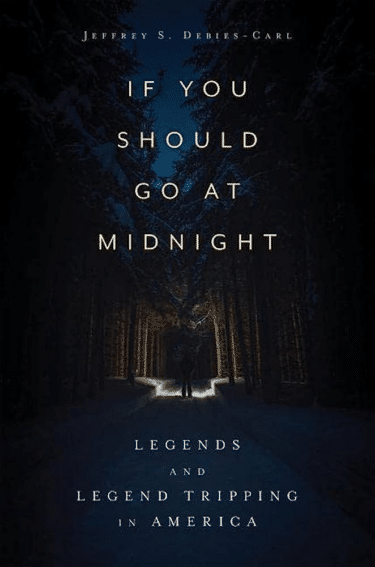Readers may not have heard the term ‘legend tripping’ before, but you’ve probably been legend tripping, and you’ve quite likely watched one of the many extraordinarily popular movies about the practice, from The Blair Witch Project to The Conjuring. You may even have had the fortune to stumble across one of the many legend-tripping TV shows, from the UK’s Most Haunted to American paranormal investigator Zak Bagan’s Ghost Adventures.
Legend tripping, for the uninitiated, is a pilgrimage made to a site with some kind of legend, extraordinary or supernatural occurrence – perhaps most obviously ghost hunting, but also to sites of UFO encounters, urban legends, historical sites and scenes from true crimes like The Historic Lizzie Borden House.

Legend tripping has become a subject of some discussion for folklorists and anthropologists in recent decades, especially in the USA, and the practice is the subject of If You Should Go at Midnight: Legends and Legend Tripping in America, a new volume by sociologist Jeffrey S. Debies-Carl.
Drawing on online accounts, more traditional documentary evidence and his own extensive fieldwork, Debies-Carl breaks down legends trips into their component stages in the book, before going on to some interesting discussion around the purpose of legend tripping in modern society.
The archetypal legend trip involves a legend recounted, often by bored teenagers with access to a car, that relates to a particular site of mystery, perhaps a cursed or haunted graveyard or house, and often off-limits – especially at night for the bored adolescents! This is a fascinating insight into American legends in particular, some of which were quite unfamiliar to me, such as the eye-bulging, goblin-like, degenerate humans known as “Melon Heads” in the Midwest and Connecticut.
Preparations are made, from a quick Google for directions for the more spontaneous trip, to packing electronic ghost-detecting gear or Bigfoot-hunting equipment for the more carefully-planned adventures. While Debies-Carl is more interested in how legend trips work than whether the legends themselves are true, he does characterise much of what takes place from a sensible standpoint, for example arguing that these preliminary activities “prepare the legend trippers for the events to come… a sense of expectancy and a willingness to accept wondrous, otherworldly possibilities that they might not otherwise find easy to entertain.”
Then comes the journey itself. Legends trippers may encounter trials as they hunt for the entrance or location of a certain graveyard or an abandoned hospital, which may be unclear or even deliberately obscure. Further tribulations include the intentional hindrances that authorities or even private property owners may have in place; Debies-Carl reminds us that the owners of houses associated with legends don’t appreciate the endless troupes of legend trippers, which has led, unsurprisingly, to violent confrontations, including a 2006 shooting in Ohio that left a girl partially paralysed and the shooter serving a sixteen-year sentence.
The destination for one’s legend trip need not be far, though, as long as there is a boundary of some sort to be crossed, which could be as simple as climbing the stepladder into your dusty, ill-lit loft.
Rites and rituals follow, whether to inflame or summon the spirit or supernatural happening, or to placate them. Debies-Carl notes that the effect is the same either way; they reinforce the fear expectation and make the encounters more likely.
Although Debies-Carl visited plenty of legend sites and slept in haunted bedrooms, the supernatural encounters the rituals were meant to provoke never seem to happen to our enthusiastic but dry author, for whom prosaic explanations for flickering lights seemed understandably more plausible than the alternatives, though he notes that being primed with the previous steps did at least make him consider the supernatural alternatives.
He explains that “legend trippers frequently interpret even subjective feelings or ‘mood’ as having been caused by some supernatural source,” before recounting a tale of a midnight adventure at Saint John’s University in Minnesota, “where the ghost of a drowned monk is said to roam.” These Minnesotan legend trippers didn’t actually see or hear anything at all, but say that the experience of being there was so spooky that they left before anything ghostly or supernatural could happen. As Debies-Carl notes, “even the absence of evidence can be interpreted as the proof.”
It should come as no surprise by this point in the review that the book is full of references to work by Chris French, Elizabeth Loftus, Richard Wiseman and even Carl Sagan.
The legend tripper must then retreat, potentially in haste, to return to the normal world, and go on to tell the tale of the adventure. They may have something relatively concrete (though hardly supernatural for those who know the science) such as orb-photos or, if they were especially well-prepared, EVP recordings, or just a tale to tell of the adventure. The author recounts a particular experience from his own childhood, where lights seemed to be moving inexplicably, that he only learned the explanation years later: the autokinetic effect and social psychology.
Debies-Carl finishes with a discussion of the role of legend-tripping as a rite of passage – or rather, as he is at pains to point out, an activity that is rather better than traditional adulthood rituals and rites of passage. While legend tripping can have dangerous consequences, from the aforementioned shooting to a role in causing the Satanic Panic of the 1980s, he convincingly argues this is a more positive and enjoyable activity than, say, the hazing involved in fraternities.



